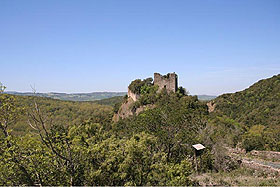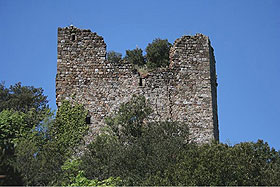Fortress of Berignone
 |
 |
| Photos courtesy of https://www.fototoscana.it/ |
The ruins of the Castello dei Vescovi (literally “Castle of the Bishops”), also called “Torraccia”, are found in the Berignone-Tatti forest, situated at about eight linear miles south-southeast of Volterra. The easiest itinerary for reaching the isolated castle takes about half a day. From Volterra follow the SS68 towards Castel S. Gimignano/Siena, and after about 5 km turn right towards Mazzolla. Before you reach the town, take the unpaved road that curves to the left and then turn right at the first crossroad. Follow this road until you reach the Batazzone farm and from her take the sharp left that goes into the Fosci valley. Continue along this road until you reach the chain that block the road where you will need to leave your car, and from where you need to go on foot or by mountain bike. After passing Capannone, you will reach the site of the ruins in about 45 minutes.
| Sponsored Link |
| Excursions
in Tuscany and Italy Private guided excursions by bus or car and tours to designer outlets, wineries for wine tasting, Chianti and Brunello tours, Tuscany country tours and more ...[»»»] |
» Where is Berignone-Tatti
Forest?
 The
castle know as the “Fortress of Berignone” (from
the name of the forest in which it is located, a large forest complex
that even today still maintains its incredible natural beauty), “Castle
of the Bishops” or simply “Torraccia”,
is an important fortification south of Volterra on a
rocky spur where the Rio canyon and the Sellate stream meet, in the upper
Cecina valley.
The
castle know as the “Fortress of Berignone” (from
the name of the forest in which it is located, a large forest complex
that even today still maintains its incredible natural beauty), “Castle
of the Bishops” or simply “Torraccia”,
is an important fortification south of Volterra on a
rocky spur where the Rio canyon and the Sellate stream meet, in the upper
Cecina valley.
There is documentation of the castle already in the year 896 when Adalberto Marquis of Tuscany gifts it to Alboino, the Bishop of Volterra. Since then it has been a fortress and also the residence of the Bishops of Volterra (hence its name), used for administering justice, for minting coins, but above all as a refuge during the long struggle against the Comune. More than once, the Bishops retreated in order to avoid retaliation as they did after their victory in Benevento when they escaped to the fortress in order to avoid the assault of the Ghibellines.
In 1361 Berignone revolts against the Comune of Volterra, but is quickly brought back to order. In 1381, the inhabitants of Berignone themselves ask for Volterra’s help in defending the castle, now occupied by relatives of Simone dei Fagani di Reggio, Bishop of Volterra. Several skirmishes followed until peace was finally declared on the 5th of February in 1382. In 1399 the castle was again occupied by the Sienese and from this moment the fortress began its decline.
Today, only ruins remain to dominate this vast forest, populated by boar, deer, and birds of prey, but just by looking at these ruins one can imagine the architectural strength and elegance of these ancient buildings.
| Back to Homepage |
| Back to Castles Index |